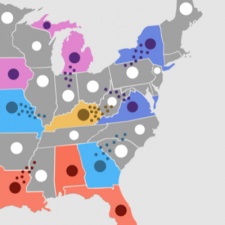Dmitry Zusman is product owner at Azur Games.
At the end of 2020, we were trying to come up with ways to improve one of our well-performing point capture games with the guys from Airion.
If anything, there were too many ideas on how to do this. It would have to be completely redone, which was impossible because user acquisition was already in full swing.
At some point, I saw a multi-colored map for vote counting during the elections and had a thought: what if we take the existing core gameplay, apply it to real-life maps and create a new, more dynamic and engaging game - State.io - with the same development team.
We discussed the ideas together, drew up a roadmap and started development.
In this article, I’m going to share the exact steps we took to make State.io exponentially outperform its predecessor.
How it all began
Let's go back a little. In 2020, we had the idea to make a hypercasual real-time strategy where the players need to capture neutral and enemy points by attacking them with units accumulated in the points that have already been captured.
We quickly put together two prototypes, both in 2D and 3D, and ran the creatives based on them through A/B testing on a real audience.
The metrics were about the same, so we settled on 2D because it was easier to make new skins and update the game this way.
This is how Clash of Dots — State.io’s forbearer — came to be. The gameplay looked like this.
The game performed well, Day 1 retention was over 40 per cent and the CPI in the US was somewhere around 20 cents.
It made over $100,000 in a year, but everyone had a plethora of ideas on how to improve it.
In fact, I wanted to redo it completely.
- There’s only one opponent in Clash of Dots, but I wanted to make it possible to play against several.
- Clash of Dots gameplay is complicated by the fact that you need to upgrade the captured points as you’re trying to beat the level. Plus, there are two kinds of upgrades: increase growth rate for units or turn the point into a defensive tower. We wanted to make a truly hypercasual one-gesture game.
- I wanted to make level design more meaningful and attractive, not just abstract maps and obstacles.
- Monetization could use some improvement as Clash of Dots had a lot of interstitial ads but very few reward clips. For instance, players could only unlock new skins or double the reward for watching ads.
Why didn't we just update the existing game accordingly? Clash of Dots already had established gameplay mechanics, level design and meta, and our User Acquisition team was actively working on the project. The game was consistently profitable and it was no longer possible to change something radically.
It became clear to us that the project is going to be a hit literally the first day after the test traffic was launched.
But it was clear that the game could perform better. We wanted a deeper meta and better retention. Then, at some point, I saw a map used to keep track of the votes by state during the 2020 US election.
There was a very nice infographic that showed the vote count in real time, each state painted in gray, red, or blue. The colors were darker for the states that already had the results and lighter for the ones that were still counting. That’s how I got an idea to add something similar to the mix.
I’ve put together a preview, showed it to the guys at the company and to the developers, they offered their own ideas and we started making a new game — State.io.
First prototype and first metrics
Development started at the end of 2020 and in January 2021 the first prototype was ready. Initially, we wanted all the states to fit on one screen and worked on it for the first two or three iterations.
It didn’t work very well in portrait mode, and we came to the decision to split up the US map into several levels.
We took the color palette for units and the starting map from Clash of Dots. On top of that, we added gradients — the more units are in one region, the more intense the player's color is, just like with the elections.
Proceeding with our plan, we added several enemies on one map and launched the first CPI test without ads. We got 20 cents in the US and R1 a little over 30 per cent.
By that time, we'd been running Clash of Dots for almost nine months and knew all its nuances: what players like, where they leave, how monetization works. So, we made several updates.
The player sees a map of states and immediately understands which piece they can capture and where to go next.
First, we decided that tower upgrades during the game had to go and put the upgrades on the main screen. From that point on, players could increase the number of starting units, their accumulation speed, and the amount of in-game currency they earned while being offline outside the gameplay for in-game currency and viewing ads.
As a result, each gameplay session was reduced solely to dragging and dropping units. The game became very dynamic and showed growth on the very first LTV test — we tripled the profit with a little more on top. Day 1 retention raised a little over 40 per cent.
It became clear to us that the project is going to be a hit literally the first day after the test traffic was launched.
We kept monitoring the metrics — R7 showed 10 per cent, and R30 showed 4 per cent. With these metrics, the game earned $1 million in the first three months and is still going steady, bringing in an average of $250-300,000 a month versus $5,000 for Clash of Dots.
The work doesn’t stop, and we see many more growth points for the project. But first, let's talk about the features that led to us getting those metrics.
Key features
Despite being similar in core mechanics, the two projects perform completely differently and there are several reasons for this.
1. Engagement and diversity. No matter how you tweak the maps in Clash of Dots, no matter how many labyrinths you come up with, the players are more interested in playing on real maps of countries anyway.
The player sees a map of states and immediately understands which piece they can capture and where to go next. Then comes the realization that there should be another familiar map after the US, and they get curious which one it’s going to be.
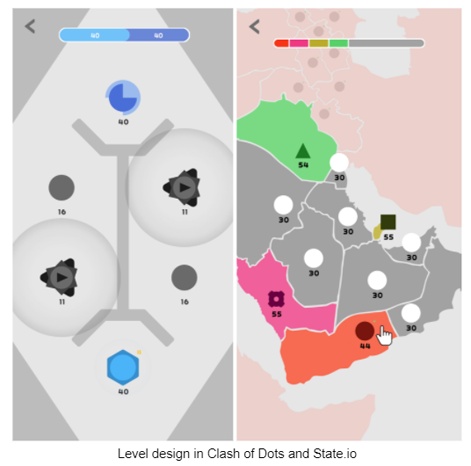
Diversifying the levels wasn’t the goal with Clash of Dots, they’re rather monotonous and there’s always only one opponent. In State.io, users can play against one, three or five bots. This is an intrigue in its own and it gives the gameplay a completely different vibe, which is important.
2. Monetization. Clash of Dots didn’t have that many opportunities for the player to watch an ad and receive a reward for it. There are skins for towers and units, different player colors, you can increase the end reward for the level and that's it.
State.io has all of those as well, but now the players are also offered to improve one of three parameters — the number of starting units, their growth rate, and the rate of passive earnings of in-game currency (offline earnings) — every time they enter the game. That is, there are many more options for ad rewards.
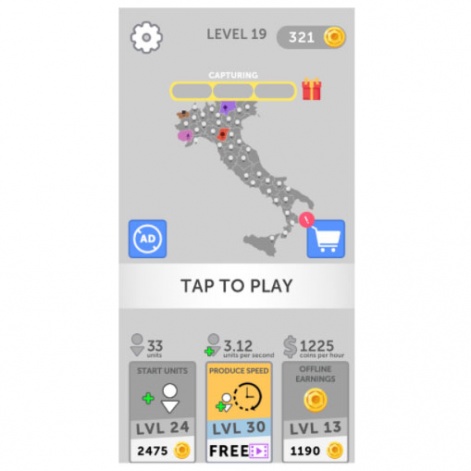
3. Simplicity and dynamics. On the contrary, the game became more simple in terms of gameplay. It became an almost perfect embodiment of the hypercasual genre — you transfer the units with one swipe and that's it. In Clash of Dots, you needed to tap the towers for upgrade options while actively trying to dominate the map.
Players often upgraded the wrong branch or deleted stuff by accident. It caused negative emotions, dragged down the gameplay dynamics and made it more complicated in general. In other words, Clash of Dots is more about waiting and accumulating units.
In State.io, you don't have to wait, you have to stay ahead of the curve. As soon as the enemy has cleared the point, you transfer units there. While you attack the upper points, the lower ones accumulate the units you need for defending your weakened regions. All in all, this makes the game more dynamic and action-packed.
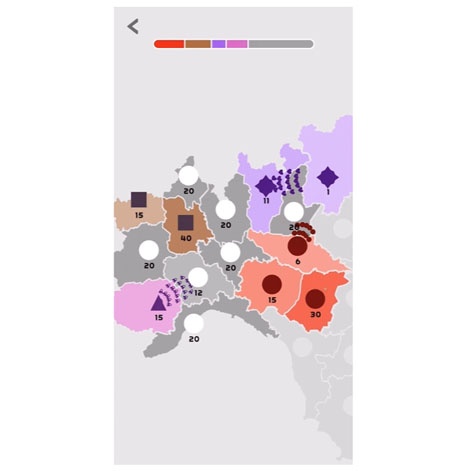
At the same time, the entry barrier gets lower — you can start playing right away without having to learn anything. In Clash of Dots, the player needs a tutorial that explains that different towers behave differently, what the upgrades are, and how to play.
There’s no tutorial in State.io, everything is very clear from the start. Because of this, 7-10 per cent of users leave Clash of Dots at the beginning, but the situation is much better for State.io.
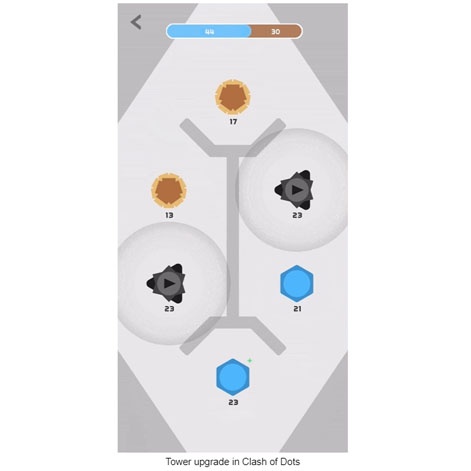
4. Personalization. Maps perform differently in different countries. For instance, American players like the US map the most.
We try to use this to the fullest, both in advertising and in ASO. That’s a lot of room for creativity and it works. We do everything with the forecasted success of ad creatives in mind, even new content.
Room for improvement
For the first few months we were focused on expanding content: maps, units, the obvious stuff that just works. Now it’s time to tackle bots — they’re going to become much smarter after the upcoming update. We want to add challenge, make the players feel like they’re competing against real people.
We’re also working on UI, since it’s still far from ideal. Some elements were taken from Clash of Dots, some were redrawn. It’s important that every bit of information in the upgrade slots is consistent and readable, because there’s too much of it. It took us several iterations to get to the current look, but there’s still work to be done.
In the beginning we had one looped map of the United States, now we've added almost the entire world.
Our future plans include adding modes, events and social aspects for better retention. There’s an idea to create a lobby, but it is too early to talk about it.
We also test things like side selection. At the start, the player is asked to choose blue or red. This idea also came up during the elections, but we don’t know how it affects the metrics yet.
We didn’t have any unsuccessful iterations that have gone into release so far. First, we discuss everything with the developers, then we run A/B tests for 20 per cent of the audience, and after a week or two we compare.
As a result, only the stuff that works for sure goes into a full-fledged release. LTV is a good indicator: in three or four months, it increased by 30 per cent.
However, I can’t say the same about the test results for endless upgrades. Right now, player levels are capped at 250. We saw that a lot of people play every day and wanted to give them the opportunity to upgrade, but for some reason it didn’t really affect the metrics. We rolled the update back to think about it some more, but most likely we’ll circle back to endless upgrades.
We’re rolling out the updates little by little in order to understand how they affect the gameplay exactly. If you release a lot of changes at once, it’ll be difficult to figure it out. To sum it up, we see all the problems and know what needs to be fixed.
There’s another key growth point — new maps. I deliberately left this point for the end because it presents a unique issue.
Disputed areas in hypercasual
In the beginning we had one looped map of the United States, now we've added almost the entire world. Simple as it may seem, just downloading vector maps and implementing them into the game isn’t enough: each one needs to be adapted for the gameplay, for example, cut into parts to avoid creating huge distances between the capture points and hurting the dynamics.
In other words, we mainly used to think about the gameplay when we worked on maps. Apparently, we had to think about the political climate in different countries as well. We were faced with this realization after one of the countries blocked the game — turns out, we were using one specific regional map with unrecognized borders.
This wasn’t intentional on our part. It was just a flaw that we quickly fixed, but now we’re more careful about this issue. For example, sometimes it’s better not to draw a state border and make a map that doesn’t divide the territories into countries at all. This way, it’s up for the players to decide who owns certain territories.
At the same time, we always emphasize that the game takes place in a fictional world, and our main goal is to create interesting gameplay, nothing more.
Final thoughts
Seemingly small changes in a hypercasual game had a big impact on the project's metrics and revenue.
We could talk endlessly about how we reworked the gameplay or monetization in order to achieve these results, but this project’s secret of success lies deeper in my opinion. It’s all about the publisher and the developer really coming together to work on something.
Prior to State.io, we collaborated with Airion on another project, developed it together and constantly gave each other feedback in order to find the right path and make new cool projects.
Game design, artwork and development are always important, but successful cases like this one are possible only when both parties are completely on the same page.

